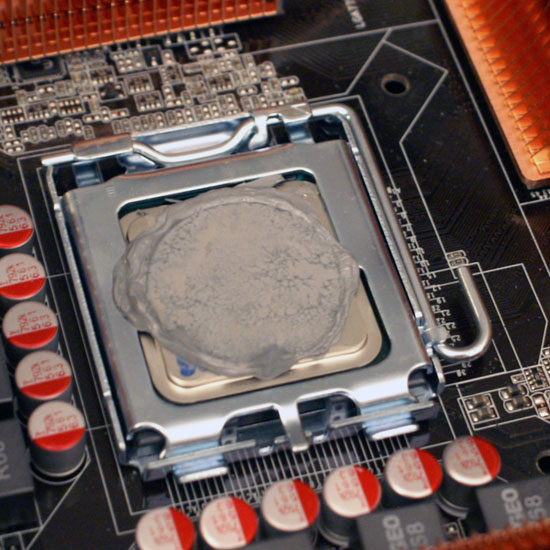Intel's Core 2 Extreme QX9770 Preview - Updated
by Anand Lal Shimpi on November 19, 2007 12:02 AM EST- Posted in
- CPUs
Um, Hot?
Not since the Pentium 4 days have we been worried about processors throttling and overheating, but this QX9770 is one hot chip. These four data-hungry cores running at 3.2GHz have given us more problems than any other Core 2 processor, including the QX9650 we recently reviewed.
Gary's QX9770 wouldn't complete 3DMark '06 without switching to a third-party heatsink. Mine wouldn't run through POV-Ray or 3dsmax without giving me lower scores than the QX9650 due the processor's internal temperature protection reducing its clock speed during the benchmarks.
These chips are early silicon and Intel had better solve these issues by the time they ship (after all, people who spend more than $1K on a processor have the right to expect stability), but our chips were definitely the most finicky we've gotten out of Intel since the Core 2 launch.
We're not entirely sure the problem lies with the CPUs or the motherboards or a combination of both, since the heatsinks never actually felt all that hot and we didn't have these problems with the QX9650.

The problems do seem related to heat though, a fresh layer of thermal compound and switching to a newer Intel retail heatsink/fan fixed my issues well enough for me to run through all the tests.










27 Comments
View All Comments
supremelaw - Monday, November 19, 2007 - link
http://www.anandtech.com/cpuchipsets/intel/showdoc...">http://www.anandtech.com/cpuchipsets/intel/showdoc...
"... switching to a newer Intel retail heatsink/fan
fixed my issues well enough for me to run through all the tests."
Yep! Same 4 defective fasteners:
http://www.anandtech.com/cpuchipsets/intel/showdoc...">http://www.anandtech.com/cpuchipsets/intel/showdoc...
Sincerely yours,
/s/ Paul Andrew Mitchell
Webmaster, Supreme Law Library
http://www.supremelaw.org/">http://www.supremelaw.org/
sprockkets - Tuesday, November 20, 2007 - link
It does not explain, however, the increased power usage. In any case, the HSF mounting mechanisms on Intel's chips since the P4 have been subpar at best. First, they post warnings about how they can bend but not damage motherboards, then they switch to the current scheme. AMD's system since the K8 is simple: provide proper bracing on and under the mb and you are set.jones377 - Monday, November 19, 2007 - link
?acx - Monday, November 19, 2007 - link
Chips can have varying levels of leakage current from batch to batch or even within the same batch. The difference between the lowest leakage chip vs. highest leakage chip can be quite large. Chips with high leakage are usually faster than chips with lower leakage. The power draw is probably due to high leakage because of the large increase in idle power usage of QX9770 vs QX9650 (58W). Subtracting 58W from QX9770's full load power consumption yields 209W. This is 9% more than QX9650's power consumption under full load. This is a more reasonable difference in power consumption given the increase in clock speed and FSB. Leakage also increases at higher temperatures. A very fast part on the borderline of acceptable leakage may fail at lower temps than a slow chip with more leakage margin.MrKaz - Monday, November 19, 2007 - link
Could you do some double check the CPU voltage?How the power consuming grow up so much for just 200Mhz increase?
(It’s 4 x 200Mhz) but even so.
Is Intel getting the same P3 1.133MHZ bug? Where the Pentium 3 couldn’t be clock more than 1.000MHZ? But this time hit at 3.2GHZ.
Or is this CPU manufactured in some other less "qualified" Intel factory?
Could you under clock it to make sure?
swaaye - Tuesday, November 20, 2007 - link
The voltage is definitely hig. Default should be around 1.25v, and that's for the 65nm Q6600. I see 1.336v being reported. That's where the power consumption is coming from.xsilver - Monday, November 19, 2007 - link
Could somebody explain why after only 2 years after the death of netburst and its super high power envelope, we are stuck in the same situation again?Also is there anything being done for future processors to rectify this problem? (besides die shrink that is)
retrospooty - Monday, November 19, 2007 - link
I think there was some other issue going on here that should have been looked into before posting the article. Most reviews of the 3ghz/1333fsb model are clocking up to 4ghz on air - now we are saying the 3.2 has issues with heat? come on, get real.mindless1 - Monday, November 19, 2007 - link
Obviously it's true, since they did measure a significant increase in power consumption which has to end up as heat. Granted some comes from the higher FSB, a very small amount only!I will speculate that one of two things is true:
1) This sample needed higher voltage to remain stable than what they eventually plan on selling through channels. They'll release their spec sheet and then we'll see, but really the numbers don't look too outlandish given the clock speed and quad cores, if the vcore is raised a bit.
2) The motherboard VRM subcircuit isn't able to handle this current level so well and excessive ripple causes higher consumption.
What would be interesting is to use the better heatsink and lower the vcore a notch to see if that regains a bit of stability, or of course to try it on more motherboards.
murphyslabrat - Wednesday, November 21, 2007 - link
OMG, can we only hope?!?If Intel responded this quickly, with a shoddy product to boot, could this mean that they are afraid of Barcelona/Agena?